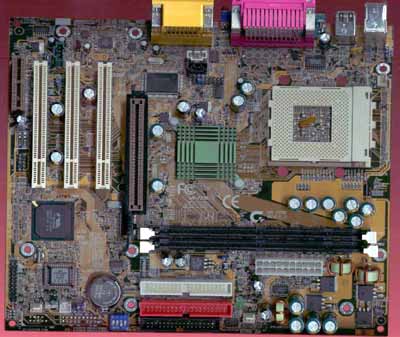Gigabyte GA-7ZMM Socket-A KM133 micro-ATX
by Mike Andrawes on March 11, 2001 2:23 AM EST- Posted in
- Motherboards
Introduction
Ever since the debut of the AMD Athlon, Gigabyte has been among the first with motherboard solutions. When the Athlon first appeared in 1999, Gigabyte quickly released the GA-7IX, which AMD eventually used in their evaluation systems.
They have not always provided the best AMD solutions, but Gigabyte motherboards are usually above average. Their AMD 750 solution, the GA-7IX, the KX133 solution, the GA-7VX, the KT133 solution, the GA-7ZX, were all among the first available with the latest chipsets for Socket-A CPU’s.
The latest Socket-A motherboard from Gigabyte, the GA-7ZXR, was not a particularly impressive one - it did get the job done just fine, but it did not really offer anything to make it stand out either. It was merely a RAID version of the GA-7ZX. In terms of overclocking the GA-7ZXR did not feature multiplier control, and in fact, Gigabyte still hasn’t released a Socket-A motherboard that allows manipulation of the CPU’s multiplier. Together with the lack of FSB speeds and merely average stability, the GA-7ZXR was, frankly, far from the best choice for a Socket-A motherboard.
Just last month VIA released the KM133 chipset, which is a derivative of the KT133 chipset that includes onboard S3 ProSavage video for the budget market. Once again, Gigabyte was the first with a solution utilizing the new chipset, the GA-7ZMM. Since the GA-7ZMM targets the low-end market, it comes in a micro-ATX form factor. It will be interesting to see how the GA-7ZMM performs under the AnandTech microscope, especially to see whether Gigabyte has provided something more than just the first KM133 solution to hit the market.
|
Gigabyte GA-7ZMM |
|
|
CPU
Interface
|
Socket-A
|
|
Chipset
|
VIA KM133 |
|
Form
Factor
|
micro-ATX
|
|
Bus
Speeds
|
95 / 100 / 102 / 103 / 107 / 110 / 113 / 115 / 133 MHz |
|
Voltages Supported
|
Auto Detect |
|
Memory Slots
|
2 168-pin
DIMM Slots
|
|
Expansion Slots
|
1
AGP Slot |
|
On-board Audio
|
Sigmatel
STAC9708T AC 97 CODEC |
|
BIOS
|
AMI Simple Setup 1.24a |
|
BIOS
Revision
|
Revision
F
|
The Layout
The GA-7ZMM comes in a micro-ATX format, utilizing a PCB of just 8.5 by 9.5 inches. The design of the board is quite compact. This helps reduce the cost of the board, and since many OEM builders will probably purchase the KM133 motherboards to be used in their systems, a small reduction in the production of the motherboard can result in a noticeable change on their bottom line.
Gigabyte also took a lot of effort to redesign the board, as the board looks quite different from the reference design. However, this work was actually done when they made the KT133 based GA-7ZM and is merely carried over to the KM133 based GA-7ZMM since the chipsets are pin compatible. For starters, the placement of the power supply connector as well as the voltage regulators have moved from behind the CPU socket in front ofthe DIMM slots. This obviously helps to make sure that the power cables does not need to go around the CPU, which may improve airflow.











0 Comments
View All Comments